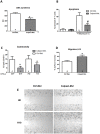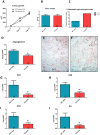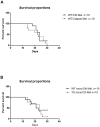The calpain/calpastatin system has opposing roles in growth and metastatic dissemination of melanoma
- PMID: 23565252
- PMCID: PMC3614974
- DOI: 10.1371/journal.pone.0060469
The calpain/calpastatin system has opposing roles in growth and metastatic dissemination of melanoma
Abstract
Conventional calpains are ubiquitous cysteine proteases whose activity is promoted by calcium signaling and specifically limited by calpastatin. Calpain expression has been shown to be increased in human malignant cells, but the contribution of the calpain/calpastatin system in tumorigenesis remains unclear. It may play an important role in tumor cells themselves (cell growth, migration, and a contrario cell death) and/or in tumor niche (tissue infiltration by immune cells, neo-angiogenesis). In this study, we have used a mouse model of melanoma as a tool to gain further understanding of the role of calpains in tumor progression. To determine the respective importance of each target, we overexpressed calpastatin in tumor and/or host in isolation. Our data demonstrate that calpain inhibition in both tumor and host blunts tumor growth, while paradoxically increasing metastatic dissemination to regional lymph nodes. Specifically, calpain inhibition in melanoma cells limits tumor growth in vitro and in vivo but increases dissemination by amplifying cell resistance to apoptosis and accelerating migration process. Meanwhile, calpain inhibition restricted to host cells blunts tumor infiltration by immune cells and angiogenesis required for antitumor immunity, allowing tumor cells to escape tumor niche and disseminate. The development of highly specific calpain inhibitors with potential medical applications in cancer should take into account the opposing roles of the calpain/calpastatin system in initial tumor growth and subsequent metastatic dissemination.
Conflict of interest statement
Figures






References
-
- Goll DE, Thompson VF, Li H, Wei W, Cong J (2003) The calpain system. Physiol Rev 83: 731–801. - PubMed
-
- Glading A, Uberall F, Keyse SM, Lauffenburger DA, Wells A (2001) Membrane proximal ERK signaling is required for M-calpain activation downstream of epidermal growth factor receptor signaling. J Biol Chem 276: 23341–8. - PubMed
-
- Su Y, Cui Z, Li Z, Block ER (2006) Calpain-2 regulation of VEGF-mediated angiogenesis. FASEB J 20: 1443–51. - PubMed
-
- Franco SJ, Huttenlocher A (2005) Regulating cell migration: calpains make the cut. J Cell Sci 118: 3829–38. - PubMed
-
- Dewitt S, Hallett M (2007) Leukocyte membrane "expansion": a central mechanism for leukocyte extravasation. J Leukoc Biol 81: 1160–4. - PubMed
Publication types
MeSH terms
Substances
LinkOut - more resources
Full Text Sources
Other Literature Sources
Medical
Molecular Biology Databases

